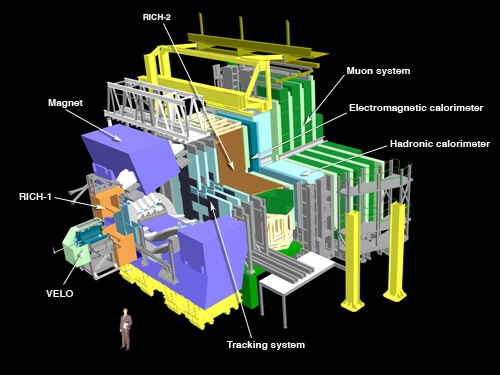The scientists and engineers in the LHCb experiment - one of the smaller experiments in Sarn - managed to discover heavy particles of food type B that decay quickly and with their help they hope to understand the asymmetry between matter and antimatter in the universe

Results from the LHCb experiment (The Large Hadron Collider beauty experiment) that were presented this week at a scientific conference that dealt with leptons and photons in Mumbai, India, that were presented last Saturday, are the most accurate of particles called B mesons that provide ways to study the asymmetry between matter and antimatter.
The LHCb experiment investigates these phenomena by observing the way in which the B meson particles decay and become other particles. The new results reinforce previous measurements by the LHCb presented about a month ago at the European Physical Society meeting in Grenoble, France, which showed that the decay of food B measured so far through calibration is fully consistent with the prediction of the Standard Model of particle physics, the theory that physicists use to describe the behavior of particles the basic ones.
"The results show that we have now been able to measure the finest details of food system B" says LHCb spokesperson Pierluigi Campana "This puts us where we need to be to start looking for cracks in the Standard Model and explain the asymmetry between matter and antimatter."
"According to current theories, matter and antimatter were present in equal amounts at the beginning of the universe, but as the universe expanded and cooled, an asymmetry developed between them, leaving a universe that appears to be composed entirely of matter. Heavy quarks provide a good place to study the phenomenon because the heavier the quark, the more ways it can decay, and all of these ways are described in the Standard Model.
The Standard Model predicts symmetry between matter and antimatter, but at a level too small to account for the fact that the universe is composed of matter. A deviation from the predictions will allow new physics to be developed. B quarks are produced in abundance at the LHC, making them the particles of choice for studying the asymmetry between matter and antimatter in the laboratory. The quarks are never produced alone, but always move in clusters. They are accompanied by another quark from the B food family and this is studied at LHCb.
Earlier this year, trials at Paralab in the US predicted results that hinted at a deviation from the standard model. Since then, the LHCb experiment has passed Parmilab in experimental accuracy and has not noticed such a deviation. "The results suggest that the devil is in the details," Campana said. "We have reached the point where we are getting down to the details. It's not the devil we expect to find there, and yet, we have new clues about a deviation from the standard model."
LHCb was able to achieve this level of accuracy so early in the operational life of the LHC particle accelerator thanks to the accelerator's good performance, and the fact that LHCb scientists are working with LHC engineers to optimize the amount of data collected in the experiment.
Unlike the large detectors used to detect all types of particles such as Atlas and CMS, the LHCb detectors were not designed to record data at the maximum rate that the LHC can provide. LHCb contains very sensitive components close to the beam, so they can measure the tiny traces produced by B-masses before they fade. Again the need to protect the devices from the damage of the beam and to maximize the strength of the beam is the challenge that the engineers and scientists have to overcome.
"The cooperation with the accelerator people was fantastic" said Campana. "It allowed us to collect data faster than expected and get closer to being able to understand where the antimatter went."
for the announcement of LHCb
http://www.newswise.com/articles/cern-s-lhcb-experiment-takes-precision-physics-to-a-new-level
For more information

4 תגובות
When is the discovery/refutation of the Higgs expected to be announced according to the current schedule?
No problem. I translated quickly.
Hi Abby,
Is it possible to correct spelling mistakes? There are many 😉
The devil is in the little details, in the big details, in everything.